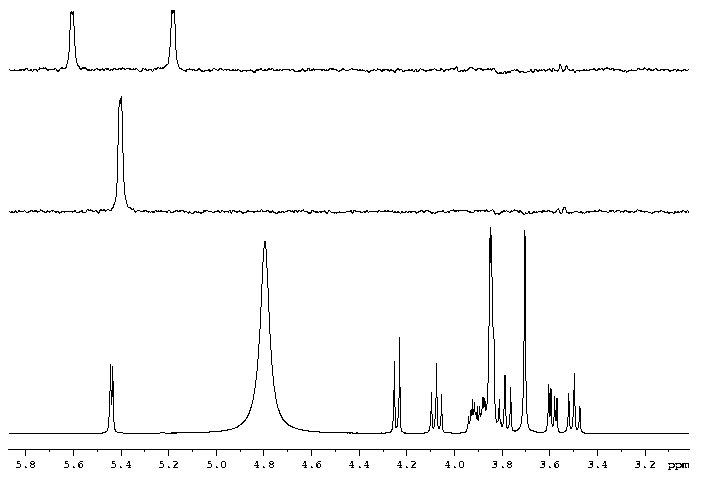|
|
The selective ge-1D HMQC experiment permit to obtain high-quality 1D HMQC spectra only showing the protons directly bonded to an specific heteronucleus (for instance, 13C). Similar results can be obtained using the selective ge-1D HSQC experiment and the selective ge-1D inverse INEPT experiment.REQUIREMENTS
Easy implementation on AVANCE spectrometers equipped with pulsed field gradients, selective excitation using shaped pulses and inverse probehead.VERSIONS
The basic pulse sequence of the selective ge-1D HMQC experiment is exactly the same as the conventional ge-2D HMQC experiment in which the following modifications have been included:EXPERIMENTAL DETAILS
- One of the two 90º 13C pulses is made selective on a specific heteronucleus. In order to improve the selectivity, proton decoupling is simultaneously applied during the long selective 13C pulse.
- The variable evolution period of the 2D version is fixed to a minimum delay (3 microseconds).
- Carbon decoupling during proton acquisition is optional. In the coupled version, the two satellites will appear as in-phase multiplet, allowing the accurate measurement of the 1J(CH). In the decoupled version, these satellites collapse in a single signal, improving the signal-to-noise by a factor of two.
The original sequences were published in 95JMRA106-112 and 95JMRA32-114 . Recently, it has been demonstrated that PEP methodology can be also incorporated in 1D HMQC pulse sequences achieving a sensitivity enhancement by a factor of 2 for IS systems ( 97JMR278 ) without change any acquisition and processing parameter. Gradients are usually applied for coherence selection purposes in natural abundance samples to obtain efficient suppression of 1H-12C magnetization. A simple variant achieves spin-state selection:
The selective ge-1D HMQC experiment can be run with minor changes from a predefined parameter set. Important parameters to consider are:SPECTRASelectivity of the selective excitation 13C pulse: the user must define the offset, the shape, the duration and the power level needed for a defined excitation profile. Optimization of the J-coupling delay as a function of 1/(2*J(CH)), in order to get in-phase magnetization of the directly-bonded protons.
In a selective 1D HMQC spectrum, only protons directly attached to an specific carbon will be present. The use of gradients allows to obtain a clean, artefact-free spectrum in a short time in which perfect suppression of undesired 1H-12C magnetization is achieved with a single two-step phase cycle.RELATED TOPICS
The selective ge-1D HMQC experiment can be used as a starting building block in more sophisticated pseudo-3D experiments:Selective ge-1D HMQC-COSY experiment
Selective ge-1D HMQC-RELAY experiment
Selective ge-1D HMQC-TOCSY experiment
Selective ge-1D HMQC-ROESY experiment
Selective ge-1D HMQC-NOESY experiment